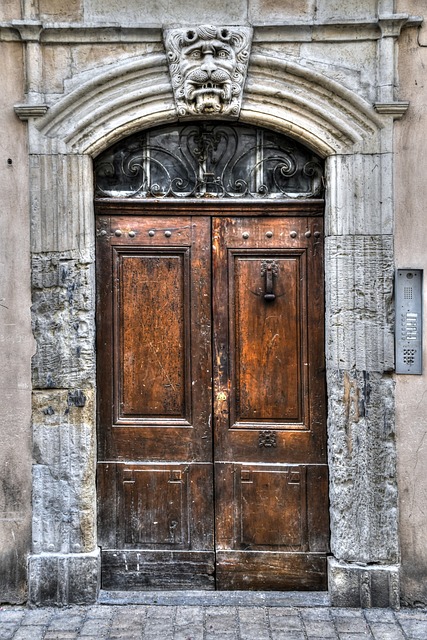Fire-rated doors are essential components of a building's safety system, providing critical time for evacuation during fires (20-90 minutes ratings). Installation requires matching door ratings to risks and adhering to local regulations. Professional installers ensure optimal safety by using proper materials, precise measurements, and airtight seals. Regular maintenance, including inspections and simple upkeep, is crucial for maximum protection. Fire-rated door installation is vital for enhancing building safety across various sectors, offering peace of mind and enhanced safety standards.
Fire-rated doors are essential components of any building’s safety infrastructure, offering crucial protection against the devastating effects of fire. These doors come rated for various durations—20, 45, 60, or 90 minutes—to withstand flames and slow their spread. This article delves into the intricacies of fire-rated doors, covering types and ratings, factors influencing resistance, installation processes, benefits across different buildings, and maintenance tips to ensure prolonged fire protection. For anyone considering fire-rated door installation, this guide offers valuable insights.
Understanding Fire-Rated Doors: Types and Ratings
Fire-rated doors are an essential component of any building’s safety system, providing critical protection against the devastating effects of fire. These doors are designed to slow down or stop the spread of flames and smoke, offering vital time for occupants to evacuate safely. The ratings—20, 45, 60, or 90 minutes—indicate the door’s ability to resist a fire for the specified duration.
When considering fire-rated door installation, it’s crucial to understand that each type is tailored to specific needs. For example, doors rated for 20 minutes are suitable for interior spaces where fire risk is lower, while 90-minute ratings are required for high-risk areas like escape routes and assembly points. The selection process involves evaluating the building’s use, fire load, and local regulations, ensuring that the chosen door meets or exceeds safety standards.
Factors Influencing Door Fire Resistance Rating
The fire resistance rating of a door is determined by several factors, crucial for ensuring safety in case of a fire. One primary factor is the material used in construction; different materials have varying levels of resilience against heat and flame. Steel doors, for instance, are often rated for longer periods due to their superior strength and ability to retain integrity under extreme conditions.
Another significant consideration is the door’s design and assembly. The way panels are joined, the presence of glass or other insulating layers, and the quality of sealing around the frame can all impact the overall fire resistance. Proper installation is paramount; a poorly fitted door may not provide the expected level of protection, highlighting the importance of professional fire-rated door installation for optimal safety and integrity.
Installation Process of Fire-Rated Doors
The process of installing a fire-rated door involves several precise steps to ensure its effectiveness in safeguarding against fire and smoke penetration. It begins with measuring the opening, ensuring accurate dimensions for a perfect fit. The door, rated for specific fire resistance times (20, 45, 60, or 90 minutes), is then chosen accordingly. Installation often requires specialized hardware and sealing materials to create an airtight seal, preventing smoke and flames from passing through gaps.
Professional installers secure the door into the frame, paying close attention to details like hinges and latches, which are critical for proper operation during a fire event. Testing is a crucial final step to verify the door’s integrity and fire resistance, ensuring it meets the required standards and provides the intended level of protection. This meticulous installation process is vital for maintaining the structural integrity of buildings and protecting occupants in the event of a fire.
Benefits and Applications in Various Buildings
Fire-rated doors offer a multitude of benefits, serving as a vital line of defense against the devastating effects of fire and smoke. Their primary advantage lies in providing crucial time for occupants to evacuate safely during a fire emergency, thereby reducing the risk of injury or loss of life. These doors are designed to slow down the spread of flames and heat transfer, allowing for essential minutes—or even hours—of protection.
The applications of fire-rated door installation span various types of buildings, from commercial offices, schools, and hospitals to industrial facilities and high-rise apartments. In office buildings, these doors ensure that employees have adequate time to gather at assembly points, while in healthcare facilities, they facilitate the separation of wards or areas to contain fires within specific sections, minimizing damage to sensitive patient care areas. Industrial sites often require fire-rated doors to protect critical equipment rooms or storage areas with hazardous materials, preventing the release of dangerous substances during a blaze.
Ensuring Proper Maintenance for Extended Fire Protection
Proper maintenance is key to ensuring that fire-rated doors provide the maximum level of protection for the intended period, whether it’s 20, 45, 60, or 90 minutes. Regular inspection and upkeep are essential components of a comprehensive fire safety strategy. This includes checking for any signs of damage, wear and tear, or corrosion, as these can compromise the door’s integrity during a fire event.
Fire-rated door installation is not a one-time task but requires ongoing care. Simple maintenance practices like keeping doors painted and sealed, ensuring hinges and closures are lubricated, and regularly testing closure mechanisms can go a long way in maintaining the door’s effectiveness. Additionally, staying informed about industry standards and regulations related to fire safety ensures that any necessary upgrades or replacements are implemented promptly, safeguarding lives and property within the building.
Fire-rated doors are essential components in ensuring building safety, providing critical time for evacuation during a fire. With ratings ranging from 20 to 90 minutes, these doors play a pivotal role in structure protection and occupant safety. Proper installation and regular maintenance are key to maximizing their effectiveness. By understanding the factors influencing these ratings and implementing the right fire-rated door installation strategies, buildings can enhance their fire resilience and offer greater peace of mind for all occupants.
